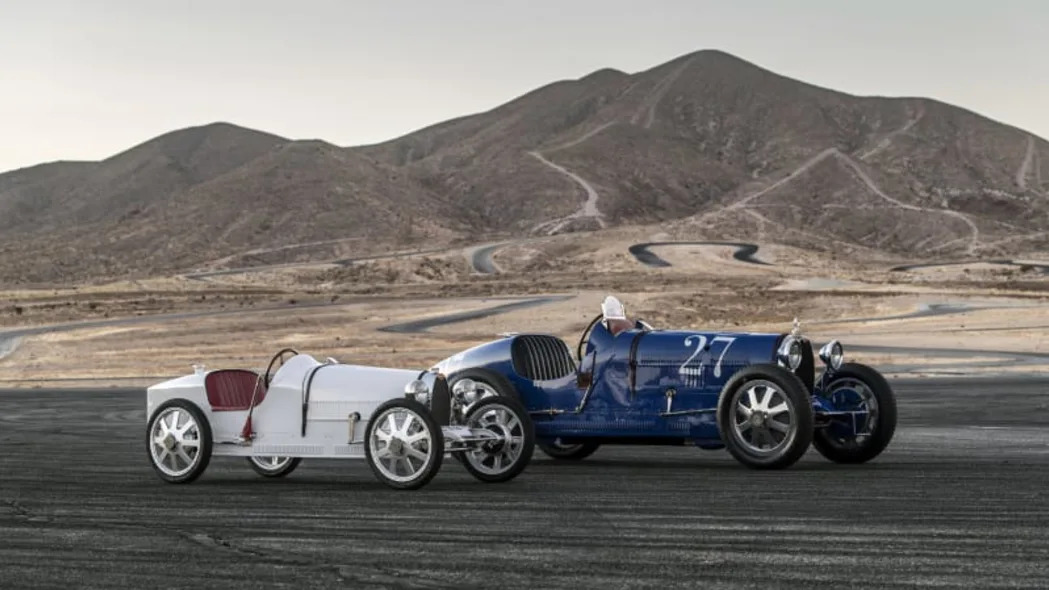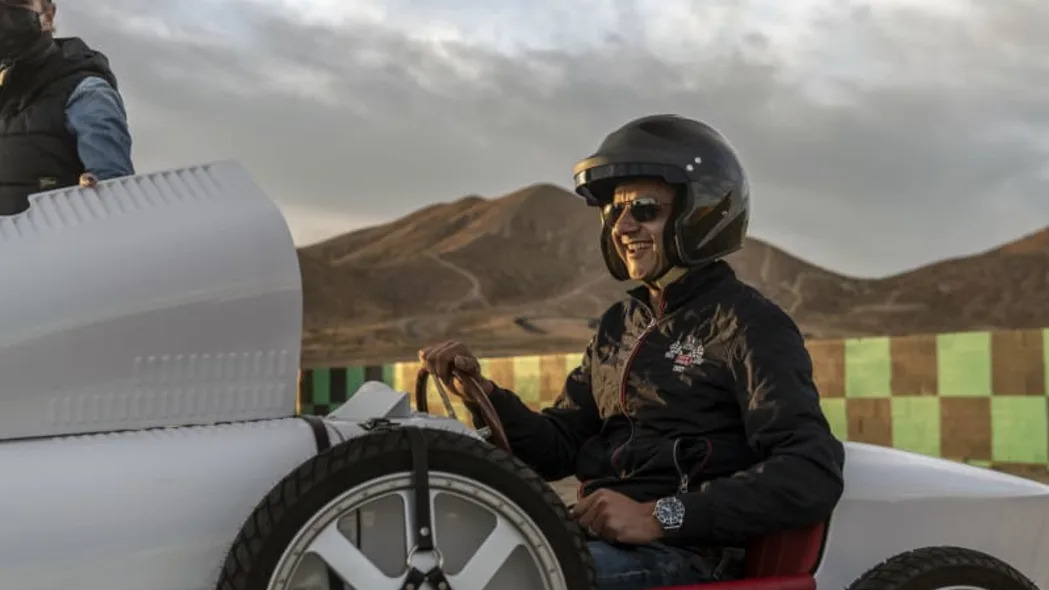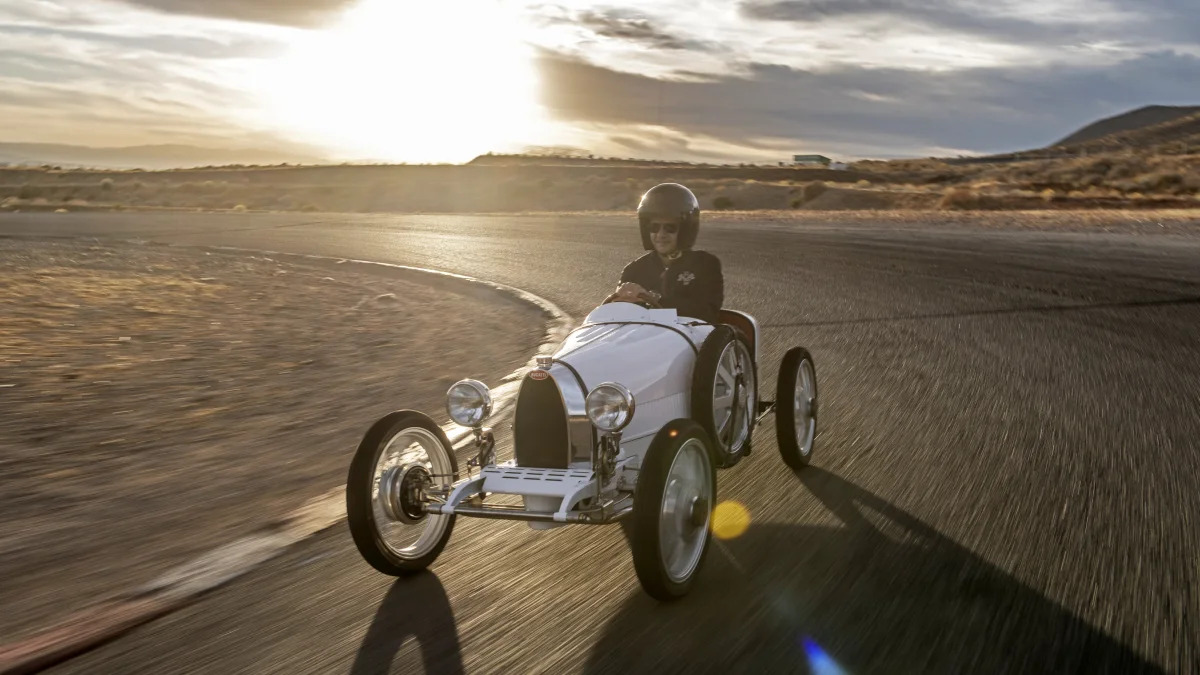The Bugatti Type 35 is one of the most unmistakable race cars in history. Powered by a screaming straight-eight engine that was often fitted with a supercharger, the open-wheel single-seater earned more than 1,000 victories back in the day, making it the winningest race car in history.
Parked alongside an original 1925 Type 35C owned by Peter Mullin, the Little Car Company’s three-quarter-scale Bugatti Baby II looks like the Molsheim masterpiece was left in the dryer too long. Inspired by the subscale model Ettore Bugatti built for his son’s fourth birthday (and later reproduced for his customers), this Baby Bugatti II is an officially licensed product that’s considerably more attainable than the original, multi-million-dollar classic. The limited-production plaything comes in base ($36,600), Vitesse ($53,000), or Pur Sang ($71,400) configurations.
Although “all 500 cars were accounted for,” according to Bugatti, “some clients have had a change in circumstances due to recent global events.” Thus came about Autoblog’s opportunity to sample one.

The entry model has a 1.4 kilowatt-hour lithium-ion battery, while the Vitesse and Pur Sang get a 2.8 kWh unit (good for about 30 miles of range) and upgraded powertrains capable of up to 42 mph once they’re “unlocked” with a speed key. Without the jailbreak, all models are capped at 12 mph in novice mode, or 28 mph in the standard setting. In the paddock at Southern California’s Streets of Willow circuit, the diminutive racer feels considerably less menacing than the real deal, whose imposing silhouette and seven-figure value make it seem impossibly intimidating. The little guy is more, well, inviting. There are still expensive-looking details such as the Bugatti macron made of solid silver, beautifully finished suspension linkages, and a turned metal dashboard.
Also lending it an elegant presence is the fact that its shape is based on a 3D scan of the original: Apart from the wheels that are outfitted with slightly lower-profile Michelin tires, the overall proportion is convincingly pleasant. Base models come with composite bodies, while Vitesse gets a carbon fiber skin and the Pur Sang features an aluminum outer layer that requires over 200 hours of handcraftsmanship to complete. You can also order your non-base model in fancy-sounding vintage Bugatti colors (like Dreyfus Blue or Junek Yellow), or selections from the same modern palette available on the Chiron (like Lorelin Violet or Jaune Molsheim). Buyers can also spec their seating surfaces in a rainbow of hides, and/or upgrade to either Bridge of Weir leather or vintage, distressed hide.

I’ve been fortunate to test all kinds of formidable hardware at Streets of Willow over the years, and high horsepower didn’t always yield simple, seat-of-the-pants fun. That said, stepping into the knee-high Baby Bugatti feels more like the world’s nicest go kart than it does any street-legal or track-focused car. There’s no seatbelt to speak of and not a whole lot of room on the bench seat — certainly not enough for a second person. However, that tailored-suit vibe does lend a feeling of specialness to the occasion, as does the mahogany and aluminum steering wheel, and the wonderfully analog speedometer, battery level gauge, and clock, whose fonts and dial designs replicate the original. Turn the main key, release the old-school handbrake, and rotate the shifter (which mimics the original car’s fuel pump), and you’re ready to silently glide away. In restricted mode there’s still enough power to offer decent acceleration, but the 12-mph Vmax arrives rapidly — and quickly gets old. Twist the speed key (which is beautifully finished in a polished aluminum fob), and the Bugatti lurches assertively forward like there was a virtual supercharger adding power to the electric motor until it approaches the 42-mph top speed. Now we’re talking.
Though the pint-sized Bug is still essentially a plaything for well-heeled adults or their trust-afarian offspring, the basic principles of performance driving still apply when you’re flinging it around a track, especially a relatively compact circuit like Streets of Willow. The mechanically linked steering produces accurate feedback of how those skinny Michelins are building up cornering load, and you can feel the weight transfer when you jam the dainty aluminum accelerator pedal or stab the brake, which actuates a set of hydraulic four-wheel drums. The stoppers have a regenerative effect, but don’t expect a significant boost to the estimated 31 miles of range, especially when you drive the way it feels like it ought to be driven: flat out. Threading my white Baby Bugatti along the track’s circuitous path was surprisingly thrilling, despite the fact that it was churning a fraction of the power produced by a “real” car.
The wind in your face; the tactile pleasure of aiming an open-wheel roadster into corners and watching the suspension geometry alter before your very eyes; the feeling of lifting a wheel off pavement during hard cornering — this is all the stuff of pure motoring that’s easily lost when you add extraneous weight and complication. And yet this so-called Baby Bugatti still manages to be inherently complicated because it’s arguably the most lovingly engineered, finely finished example of a four-wheeled thing you never knew you wanted. It rings true to its mission of offering a plush plaything that’s beautiful to look at and a joy to drive. However, beyond tossing it around on a miniature track on the grounds of your country mansion, is there really much sense in spending a BMW M2’s worth of money on a 75-percent-scale toy? If you have to ask, you might be among those who understand the so-called change in circumstance due to global events. The Bugatti Baby II is for those who don’t.










Sign in to post
Please sign in to leave a comment.
Continue